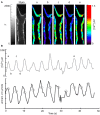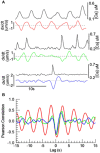Ca(2+) signaling in arterioles and small arteries of conscious, restrained, optical biosensor mice
- PMID: 25339912
- PMCID: PMC4188025
- DOI: 10.3389/fphys.2014.00387
Ca(2+) signaling in arterioles and small arteries of conscious, restrained, optical biosensor mice
Abstract
Two-photon fluorescence microscopy and conscious, restrained optical biosensor mice were used to study smooth muscle Ca(2+) signaling in ear arterioles. Conscious mice were used in order to preserve normal mean arterial blood pressure (MAP) and sympathetic nerve activity (SNA). ExMLCK mice, which express a genetically-encoded smooth muscle-specific FRET-based Ca(2+) indicator, were equipped with blood pressure telemetry and immobilized for imaging. MAP was 101 ± 4 mmHg in conscious restrained mice, similar to the freely mobile state (107 ± 3 mmHg). Oscillatory vasomotion or irregular contractions were observed in most arterioles (71%), with the greatest oscillatory frequency observed at 0.25 s(-1). In a typical arteriole with an average diameter of ~35 μm, oscillatory vasomotion of a 5-6 μm magnitude was accompanied by nearly uniform [Ca(2+)] oscillations from ~0.1 to 0.5 μM, with maximum [Ca(2+)] occurring immediately before the rapid decrease in diameter. Very rapid, spatially uniform "Ca(2+) flashes" were also observed but not asynchronous propagating Ca(2+) waves. In contrast, vasomotion and dynamic Ca(2+) signals were rarely observed in ear arterioles of anesthetized exMLCK biosensor mice. Hexamethonium (30 μg/g BW, i.p.) caused a fall in MAP to 74 ± 4 mmHg, arteriolar vasodilation, and abolition of vasomotion and synchronous Ca(2+) transients.
Summary: MAP and heart rate (HR) were normal during high-resolution Ca(2+) imaging of conscious, restrained mice. SNA induced continuous vasomotion and irregular vasoconstrictions via spatially uniform Ca(2+) signaling within the arterial wall. FRET-based biosensor mice and two-photon imaging provided the first measurements of [Ca(2+)] in vascular smooth muscle cells in arterioles of conscious animals.
Keywords: Calcium; arteriole; imaging; sympathetic nervous system; two-photon.
Figures







References
-
- Blaustein M. P., Leenen F. H., Chen L., Golovina V. A., Hamlyn J. M., Pallone T. L., et al. (2012). How NaCl raises blood pressure: a new paradigm for the pathogenesis of salt-dependent hypertension. Am. J. Physiol. Heart Circ. Physiol. 302, H1031–H1049 10.1152/ajpheart.00899.2011 - DOI - PMC - PubMed
Grants and funding
LinkOut - more resources
Full Text Sources
Other Literature Sources
Molecular Biology Databases
Research Materials
Miscellaneous

